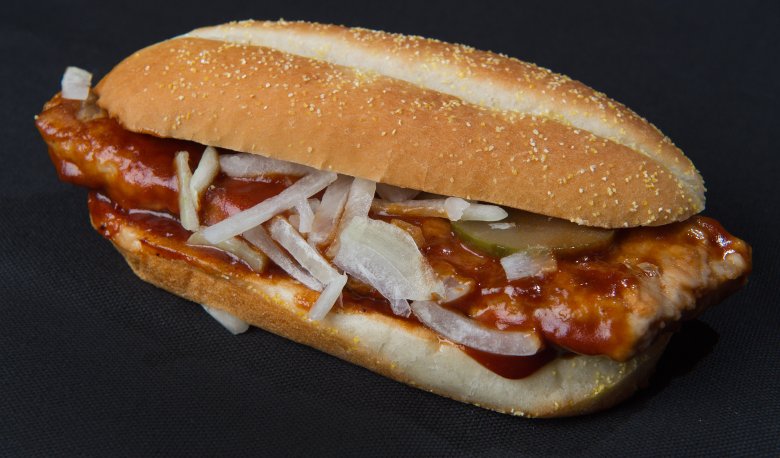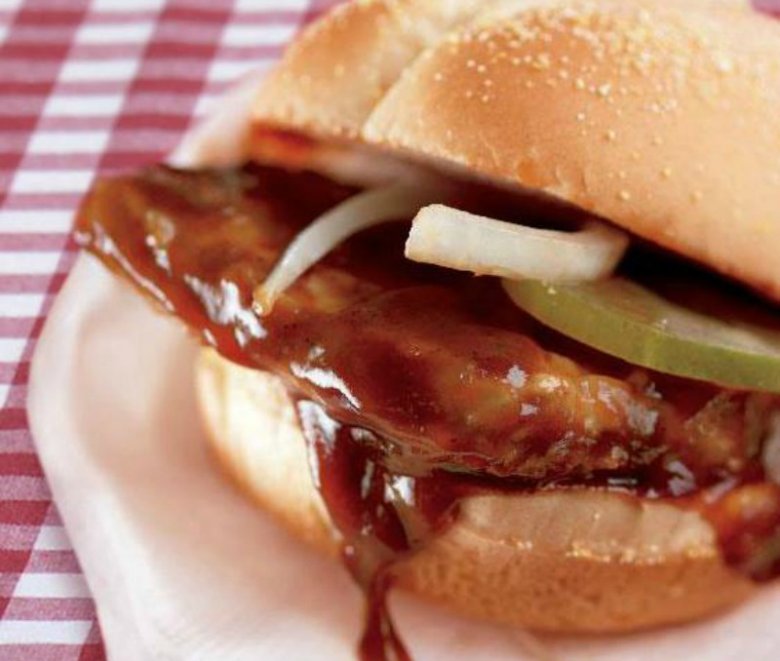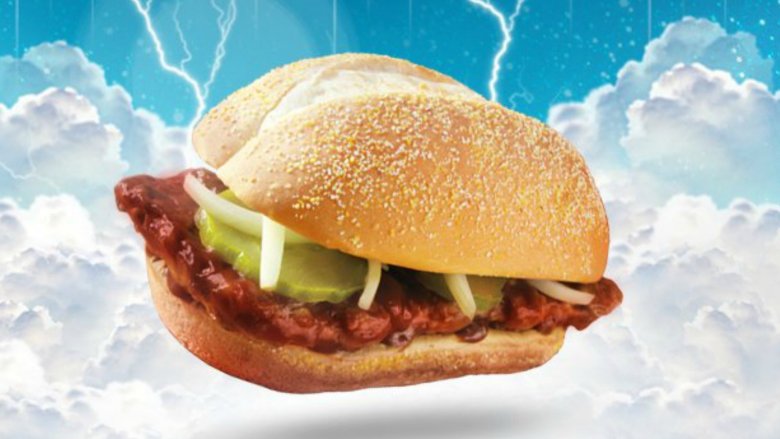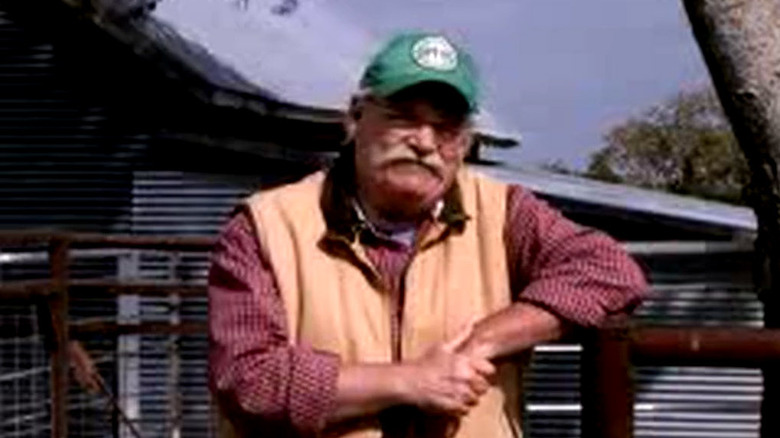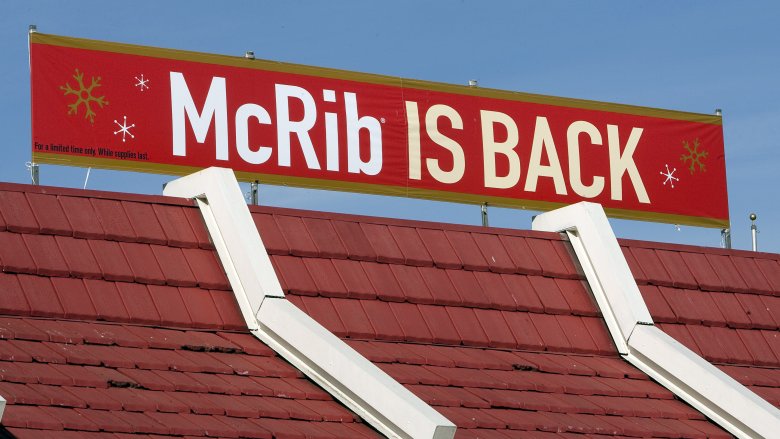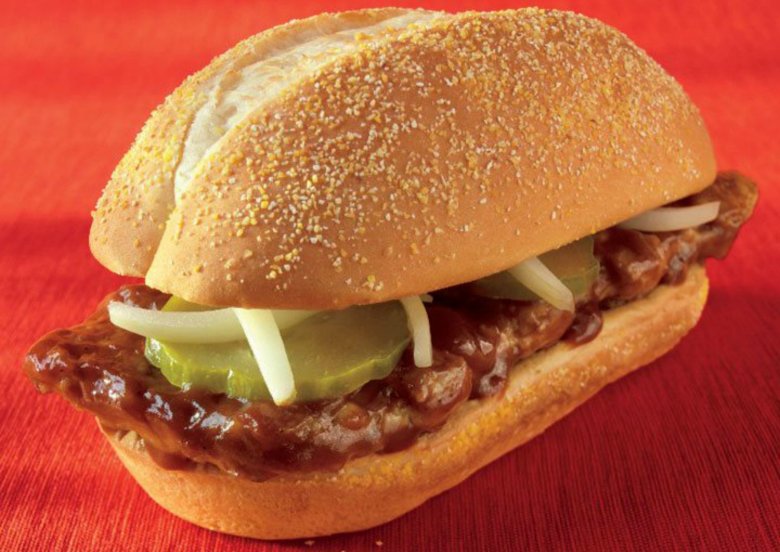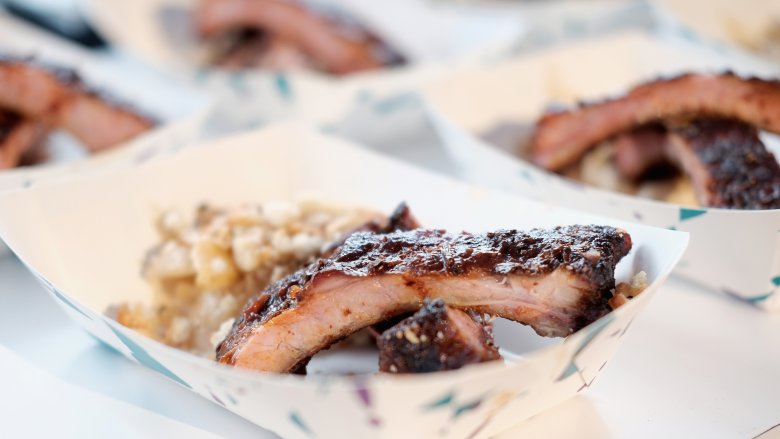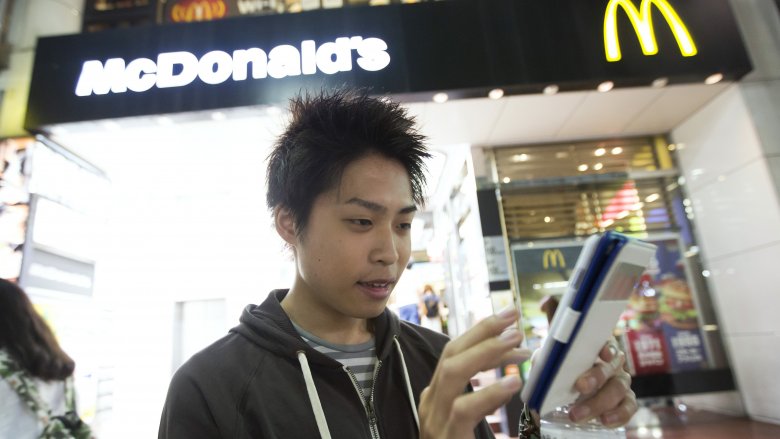Everything You Need To Know About McDonald's McRib
You know you're doing something right as a top fast food spot when the entire internet rejoices at the return of one of your occasional menu items — even if it's only back for a brief stay. McDonald's stumbled onto something pretty special with the McRib, a sandwich from the quick serve king that causes people to stop what they're doing and head to the Golden Arches whenever it pops back up on the menu — no matter how long (and slow) that drive thru line might be. So, what's the deal with the McDonald's McRib? Why does it cause such a stir, and is it really worthy of all the hype? Is it even really rib meat, and why can't they just leave it on the menu? You might think you know what's going on between those buns, but you don't really know the whole story of the famed McRib. Until now.
A food scientist came up with the McRib process
Getting a McRib to look like a cute little rack of ribs may seem like sorcery, but its roots are actually as old as the original pig concoctions. The National Pork Producers Council (there really is one) approached University of Nebraska animal science professor Roger Mandigo to come up with a way to make "shaped pork" out of pork trimmings to sell in fast food restaurants — specifically McDonald's.
Mandigo basically took the sausage making method and revamped it using salts and other additives to hold everything in place. His first concoction was shaped like... a pork chop. McDonald's wisely asked for something people would actually want on a bun, and requested that the Franken-pork resemble the boneless part of a backrib. And thus, the McRib happened.
You're not eating a gym mat — seriously
You've probably heard the tale, the only difference between a McRib and a gym mat is you can't wrestle on a McRib. The stories floating around the internet are that the McRib shares many of the same ingredients as a gym mat! Turns out that's not exactly the case.
Lopez Foods Vice President Kevin Nanke says the McRib contains only a few ingredients — meat, salt, dextrose, which is a natural starchy sweetener, and water. There are also a bunch of preservatives — but that's to be expected because it's not like they're grinding and shaping McRibs right at the Mickey D's down the street. Azodicarbonamide, the offending "gym mat" ingredient, isn't in the official ingredients McDonald's rattles off on their website. So don't sweat the gym mats, it's not in there.
But let's play devil's advocate and say that by some scientific reaction a little azodicarbonamide did end up in the McRib. The FDA says that small amounts are safe. So even if there was the big A-word in there, you're A-OK to chow down on a McRib.
It flopped at first — for financial reasons
Despite making it way past the chopped beefsteak in terms of availability, the McRib wasn't the rousing success you might think. Competition on the menu came from the also-new Chicken McNugget, plus the burgers, so it didn't take off as McDonald's had hoped. There was another problem — pork prices. Sales didn't match the increasing price of pork, so in 1985 the McRib disappeared from the menu. As much as the McRib is looked upon nostalgically as this item that got people rolling into McDonald's it was truly the Chicken McNugget that vaulted McDonald's into their untouchable status as the Fast Food King. And the menu only had room for one white meat — bye bye McRib.
The real reason for the first comeback
Despite its absence from menus, a stray store here or there would occasionally have the McRib on their menu, and a very brief return in 1991 didn't create the craze you associate with the McRib today. The first real comeback happened in 1994, all thanks to a movie.
McDonald's has always loved product tie-ins. Even way back in 1979 Happy Meals featured a Star Trek tie-in, because what little kid doesn't love Star Trek? Except all of 'em. The Arches tightened up their game over the years and eventually in the '90s they got a little more sophisticated with the tie-ins. You may recall the closing credits of the cartoon The Flintstones feature a giant rack of ribs. When the Flinstone's movie premiered, McDonald's had an epiphany, "Why not bring our ribs back?" And thus, the first national McRib return happened. Oh, and pork prices were down again. That helped too. As quickly as the movie faded from our attention spans, the McRib did the same. And pork prices rose again, which certainly helped its departure.
McDonald's created the cult following
After a few false starts in the early 2000s, McDonald's announced a "farewell tour" for the "Beloved" McRib. The internet awoke to a website (now defunct) that called for signatures to a fake petition for the McRib to remain forever, and the fictional Boneless Pig Farmers Association of America sponsored the rallying cry. And of course it was all McDonald's.
Despite the impossibility of a boneless pig and the ridiculous ads they ran, for some reason people didn't completely catch on to the charade. Each time the farewell tour extended, the rallying cry was "it worked" — and it certainly did; McDonald's created a true cult following for their own food. Urban Dictionary marks "McRib Mania" with an entry in 2010, and by 2011 news outlets reported on the return of the pork patty. Laugh all you want, but the success is in the profits, the McRib is a cult hero now.
It's actually not that popular
So despite all the hype, all the mania, all the people driving everywhere with their one-star apps trying to find the McRib, why doesn't McDonald's just keep it on the menu all the time? Well, turns out, it's just not that popular.
High pork prices might have chased it away in the 80s, but the bottom line is that McDonald's didn't sell enough of them to justify the supply cost. For something to make it at McDonald's it needs to be massively huge; McNuggets? Good. Arch Deluxe? Bad. So McDonald's did what they're very good at; they created an advertising campaign that made the McRib into the cult thing that people want. And they can roll it out when pork prices dip — like in November when that usually happens. There's nothing wrong with liking the McRib, but it's not there all the time because you're in a small minority.
It's super salty because it has to be
The McRib is made from boneless pork picnic, a cut that's known to be "tough and fatty" but certainly edible with a little magic. That process to "form" the McRib specifically involves using salt to extract proteins and using those to bind the meats together into a shape. And it takes a whole lot of salt to pull that magic trick off. One McRib will provide you 36 percent of your daily intake of salt; if that feels like a lot, that's because it is. But considering McDonald's infatuation with salt, it's not that bad of a choice at the Golden Arches.
Basically, salt added to the process will restructure the protein and act as an emulsifying agent. So the key to the dish — and the secret to getting the pork to look like you want it to — is the salt. But there's other stuff going on to make the magic happen as well.
A classically trained chef concocted it
If you figured the guy who came up with all the ideas for the food at McDonald's started as a fry cook and worked his way up, guess again. Chef Rene Arend, Luxembourg born and trained in France, worked the kitchen at the Whitehall Club in Chicago, a favorite of McDonald's founder Ray Kroc. He begged Arend to join the Arches and in 1976 McDonald's had it's very first executive chef.
As the big (Mc)Cheese Arend also had the task of coming up with new foods for McDonald's to roll out. A trip to South Carolina tickled his fancy; he tried pulled pork, a southern staple, and quickly discovered the secret to it — dressing up lower quality cuts of pork in a tangy sauce to create an edible delight. When you put it like that it's not very appetizing, but it's not too far off from what the McRib originally was.
The bun is familiar
That hoagie style bun may seem like an outlier in the McDonald's family of foods, but it's actually a leftover from another attempt at making a "non-hamburger" addition to the menu. A few years before the McRib hit stores, McDonald's tested a chopped beefsteak sandwich — a delicious concoction of chopped beefsteak and onions on a hoagie style roll and an optional steak sauce to top it off. To this day it remains the greatest thing I ever had from McDonald's, but alas, it wasn't to be. The beefsteak sandwich never made it out of testing stage despite getting a few commercials on national TV. The only thing that remains of the beefsteak is the bun — but now it has sesame seeds.
Want to know where the McRib is? There's an app for that
Despite the tom foolery to get it going, the McRib craze is real today. The McRib's November 2017 return saw the same news reports we all saw before — and there's even a website dedicated to finding locations that still carry it. This way you can drive hundreds of miles to get a pork sandwich. Sure, there's no guarantee they're 100 percent accurate (they rely on loyal McRib fans to report when and where they saw their beloved sandwich) but when you're desperate for a McRib you'll roll the dice on user-created info. Maybe just make a call to the restaurant in question before you set out on your adventure.
